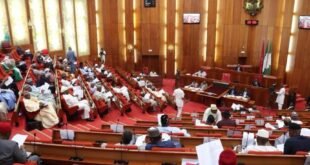Wednesday Trump announced a basal rate of 10 % on imports from all foreign countries, as well as higher tariff rates for dozens of nations that the White House considered the “worst transgressors” when it came to commercial barriers.
The 10 % rate will come into force on Friday. About 60 countries dealing with a higher mutual rate will see these rates in force on April 9 at 12:01
Trump also announced a 25 % rate on all foreign manufacture cars that will take effect at 12:01 on April 3.
Among the countries targeted with mutual rates are China, Vietnam, Taiwan, Japan, India, South Korea, Thailand, Switzerland, Indonesia, Malaysia, Cambodia and the European Union.
Trump said that those mutual rates will be calculated by combining the rate of non -monetary rates and barriers such as the currency manipulation, therefore divided in half.
“The rates will not be mutual full. I could have done it, I imagine. But it would have been difficult for many countries,” said Trump.
The highest mutual rates included 35 % on China, 20 % on the European Union, 46 % on Vietnam, 32 % on Taiwan, 24 % on Japan.
No more delays: the expiry of the real ID must be attacked
“This is one of the most important days, in my opinion, in the history of America,” said Trump. “It is our declaration of economic independence.”
Other countries with high rates include 26 % on India, 21 % on Switzerland, 32 % on Indonesia, 24 % on Malaysia, 49 % on Cambodia and 10 % in the United Kingdom.
The president provided that his enormous rates would receive criticisms, but he claimed that he also felt complaints about his management of China and the commercial agreement that he hit with Mexico and Canada in his first term.
“In the next few days, there will be complaints from globalists and outsourcers, special interests and false news,” said Trump. “But, never forget that every prediction made by our opponents on trade in the last 30 years has been totally wrong.”
Trump said that the calculation of the new rates is partly based on the values of non -tariff barriers imposed on the United States from other countries. These include measures such as protective technical speculations for exported products and currency adjustments.
Trump’s new calculations update the designations of the barriers of foreign trade in the United States trade, which have been made more indulgent under the Biden administration.
Wednesday’s announcement will not apply to Mexico and Canada. Instead, those two nations will continue to face a 25 % rate on imports for reasons that have not done enough to curb the flow of Fenanil in the United States. Trump had previously announced that the goods covered by the US-Messic-Canada commercial agreement (USMCA) were exempt from those rates.
The president made the announcement from the Rose Garden of the White House, where he was reached by Cabinet officials, including the Secretary of State Marco Rubio, the Secretary of Commerce Howard Lutnick and the Secretary of Health and Human Services Robert F. Kennedy Jr.
Trump had previewed for weeks that he would announce the mutual rates on April 2, that he and other officials of the Administration were done well as a “day of liberation”. “But Trump, in the days preceding the announcement, tried to temperate expectations saying that he would be more indulgent than many expected.
The president made the announcement with the boards of directors who flank him in the Roseto, showing graphics that outlines the tariff amount that each commercial partner puts on the United States
He was also achieved by workers of the steel industry, truck drivers and other workers who wanted to show their support for his commercial policy.
The officials expect hundreds of millions of dollars of revenue in the coming years and “trillion” for a period of 10 years with mutual rates, they told journalists.
Trump has announced the rates under the authority of the International Economic Emergency Powers Act, or IEPA, which grants the President the power to regulate imports.
The White House underlined on Wednesday that the rates are not intended as a negotiation tactic. Officials claimed that rates were necessary to strengthen US production and increase the national industrial base.
“We are very focused on inserting this tariff regime,” said a high official of the White House. “This is not a negotiation. It is a national emergency.” Experts and even some Republicans, however, have warned that the rates will lead to price increases for American consumers. Some nations have reported that they are preparing mutual rates to respond to Trump’s announcement, potentially unleashing a global commercial war.
 JamzNG Latest News, Gist, Entertainment in Nigeria
JamzNG Latest News, Gist, Entertainment in Nigeria












